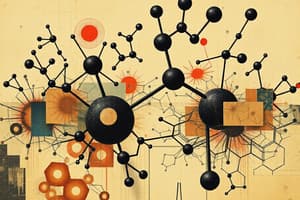Podcast
Questions and Answers
What are the four classes of large biological molecules?
What are the four classes of large biological molecules?
- Nucleic acids (correct)
- Carbohydrates (correct)
- Lipids (correct)
- Proteins (correct)
Macromolecules are large and simple molecules.
Macromolecules are large and simple molecules.
False (B)
What is a polymer?
What is a polymer?
A long molecule consisting of many similar building blocks.
What is a monomer?
What is a monomer?
What reaction occurs when two monomers bond together?
What reaction occurs when two monomers bond together?
What is hydrolysis?
What is hydrolysis?
What are monosaccharides?
What are monosaccharides?
Glucose is the most common _____.
Glucose is the most common _____.
What is the glycosidic linkage?
What is the glycosidic linkage?
Flashcards
Four classes of biological molecules?
Four classes of biological molecules?
Nucleic acids, carbohydrates, proteins, and lipids.
Macromolecules are simple?
Macromolecules are simple?
False. Macromolecules are large, complex molecules.
What is a polymer?
What is a polymer?
A long molecule consisting of many similar building blocks.
What is a monomer?
What is a monomer?
Signup and view all the flashcards
Dehydration reaction?
Dehydration reaction?
Signup and view all the flashcards
What is hydrolysis?
What is hydrolysis?
Signup and view all the flashcards
What are monosaccharides?
What are monosaccharides?
Signup and view all the flashcards
Glucose is the most common _____?
Glucose is the most common _____?
Signup and view all the flashcards
Glycosidic linkage?
Glycosidic linkage?
Signup and view all the flashcards
Study Notes
Biological Macromolecules
- All organisms are made up of four major classes of large molecules: carbohydrates, lipids, proteins, and nucleic acids
- Large biological molecules are called macromolecules and they are complex
Polymers and Monomers
- A polymer is a large molecule composed of repeating units called monomers
- Carbohydrates, proteins, and nucleic acids are polymers
- Enzymes are specialized macromolecules that speed up chemical reactions, including the synthesis and breakdown of polymers
- Dehydration reaction joins monomers together by removing a water molecule
- Hydrolysis breaks down polymers by adding a water molecule to the bond
Carbohydrates
- Carbohydrates serve as fuel and building materials in organisms.
- The simplest carbohydrates are monosaccharides, or simple sugars.
- Carbohydrate macromolecules are polysaccharides, polymers composed of many sugar building blocks.
Monosaccharides
- Monosaccharides have molecular formulas that are usually multiples of CH2O.
- The most common monosaccharide is glucose (C6H12O6).
- Monosaccharides are classified based on:
- The location of the carbonyl group (aldose or ketose)
- The number of carbons in the carbon skeleton.
Disaccharides
- A disaccharide forms when a dehydration reaction joins two monosaccharides.
- The covalent bond between two monosaccharides is called a glycosidic linkage.
Polysaccharides
- Polysaccharides are polymers made up of many monosaccharides.
- They have diverse functions including:
- Storage - starch (plants) and glycogen (animals)
- Structural support - Cellulose in plants and chitin in animals.
Studying That Suits You
Use AI to generate personalized quizzes and flashcards to suit your learning preferences.



